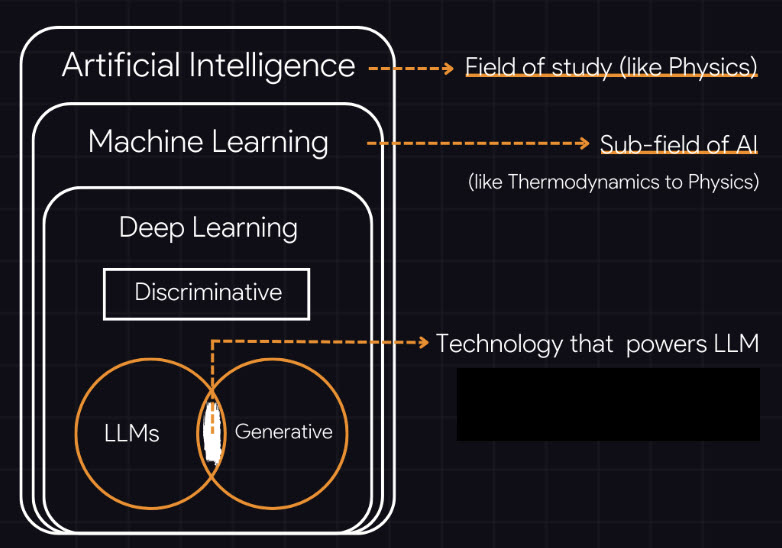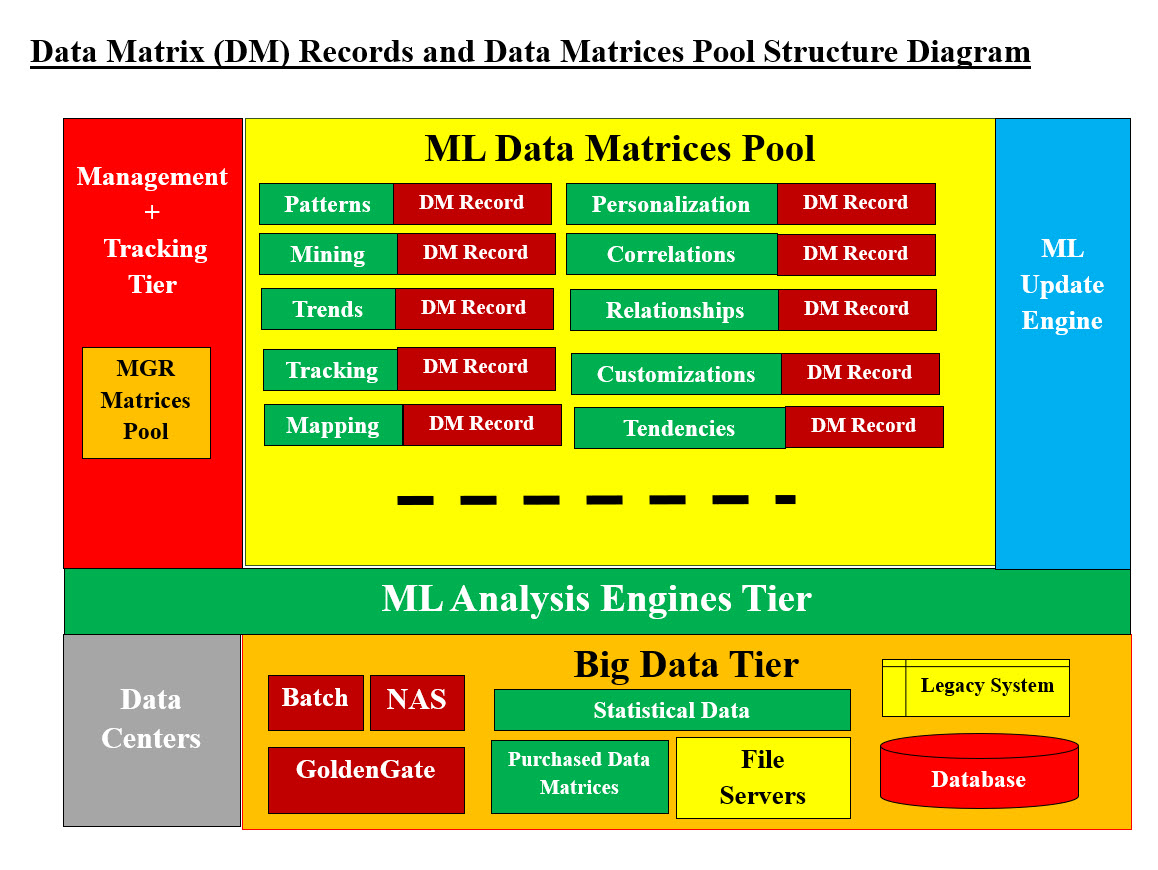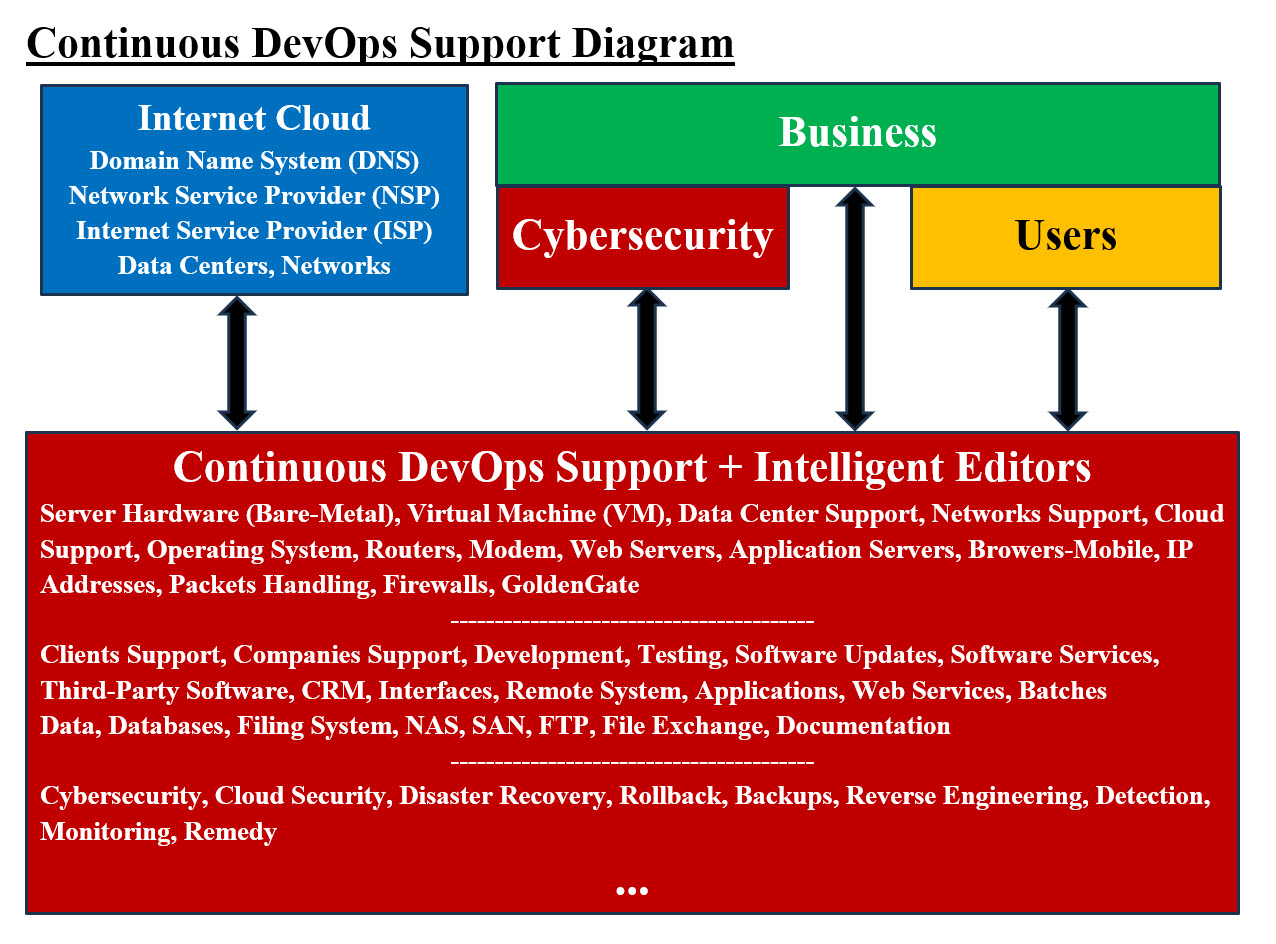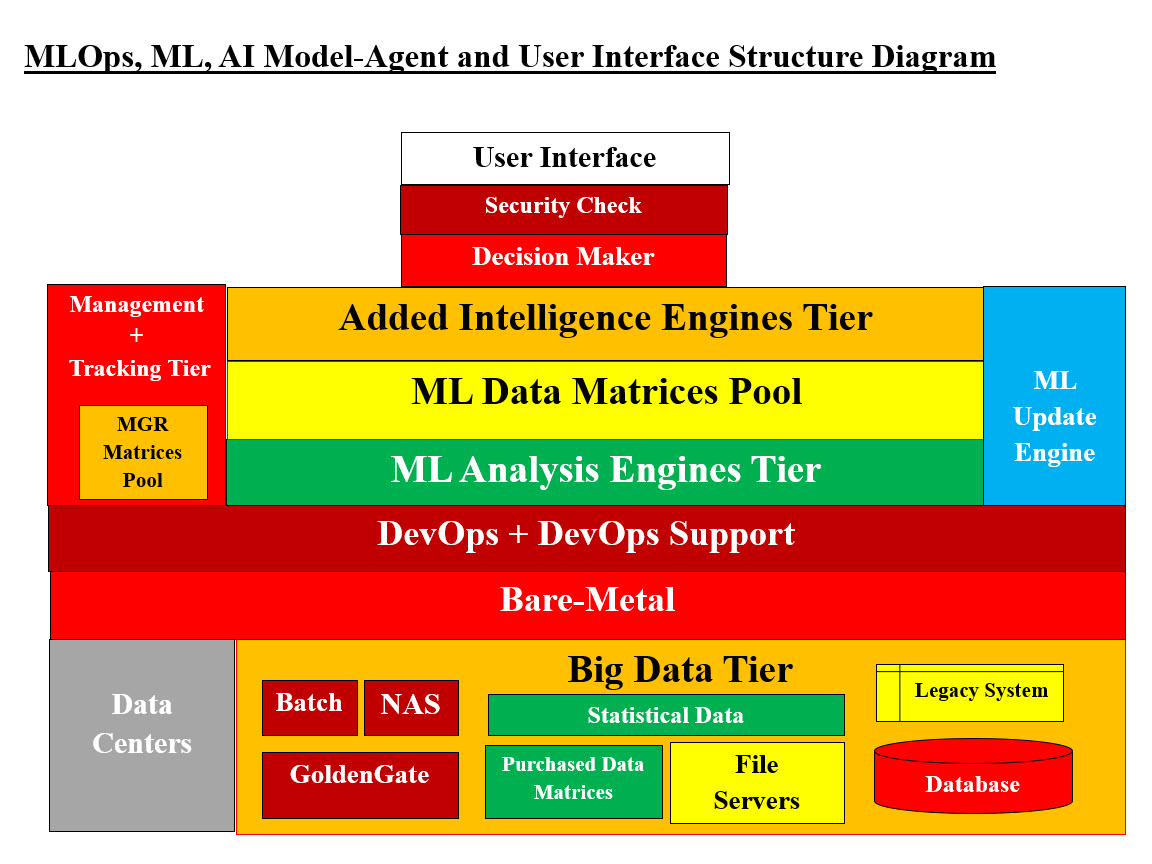
|
Sam Eldin Artificial Intelligence
MLOps© |
|---|
|
AI Machine Learning Operations (MLOps) Introduction: As an Information Technology (IT) architect-analyst-developer-PM, I am trying to get on the AI bandwagon and be a part of AI future. Sadly, I am running into a lot of incomplete answers, unclear solutions, impractical padding and overkill of baseless AI material with no value. The goal is to learn AI and use my IT experiences and tools to hopefully master one aspect of AI. We are presenting a number of topics such as our approach, architect, design, tools and development. We believe these topics are definitely worth considering and using. We will let the AI community makes their decision on the value of our approaches and implementations. The following topics are what we need to present to the AI community: • Machine Learning (ML) Approach • ML Data Analysis • Machine Learning Operations (MLOps) Internet Quick definitions Verse Our Definitions: Internet definition: Machine Learning: Machine learning is a subset of AI, which uses algorithms that learn from data to make predictions. These predictions can be generated through supervised learning, where algorithms learn patterns from existing data, or unsupervised learning, where they discover general patterns in data. ML Data Analysis: What are the different types of ML analysis? Machine learning types. Machine learning algorithms fall into five broad categories: supervised learning, unsupervised learning, semi-supervised learning, self-supervised and reinforcement learning. 
Image #1 - AI, ML, Deep LN and Diagram Image Image #1 presents the view of current AI structure and all its components. ML contains Deep Learning, Discriminative and Generative AI models plus Large Language Models (LLMs). What is DevOps? DevOps is the combination of cultural philosophies, practices, and tools that increases an organization's ability to deliver applications and services at high velocity: evolving and improving products at a faster pace than organizations using traditional software development and infrastructure management processes. Machine Learning Operations (MLOps): Machine Learning Operations (MLOps), is a set of practices that ensures machine learning models are developed, tested, and deployed reliably and efficiently. It focuses on automating the entire ML lifecycle, from data collection to model deployment and monitoring. Essentially, MLOps aims to streamline the process of building, deploying, and maintaining ML models in production. Our Definition of the Presented Topics: Our Machine Learning View: Our Machine Learning (ML) View is that ML would perform the jobs of many data and system analysts. In short, our ML is an independent intelligent data and system Powerhouse. Our ML's jobs or tasks would include all the possible data handling-processes The Analysis List Tasks-Processes Table presents the needed analysis processes which our ML would perform.
Analysis List Tasks-Processes Table We can state with confidence that no human can perform all the listed processes or steps mentioned above, but our Machine Learning would be able to perform all the tasks (included in the Analysis List Tasks-Processes Table) with astonishing speed and accuracy. 
Image #2 - ML Structure and its Containers and Components Diagram Image The main job of our ML is to turn Big Data into Data Matrices Pool for further analysis and processes. Image #2 presents our ML structure and its containers and components. The following are our ML tiers which would support our AI Model-Agent. Data Matrices Pool Structure – Two dimensional arrays for storage Data Matrix Records – Data about the matrices (we do not want to call it metadata since it is not metadata) ML Analysis Engines Processes Structure ML Update Engine Management + Tracking Tier (Management Matrices Pool) See our Switch-Case AI Model-Agent (Our AI Virtual Receptionist Systems) for further details. ML Data Analysis: The best way to present how our ML performs Big Data analysis is by presenting Our Switch AI Model-Agent 2,000 Foot View Tiered Structure as showing in Image #3. Our Switch AI Model-Agent 2,000 Foot View Tiered Structure: A 2,000 Foot-View Tiered Structure is a common business phrase that refers to a high-level, strategic perspective, allowing for a broader understanding of a situation or problem, rather than getting bogged down in the details. 
Image #3 - Our Switch-Case AI Model-Agent 2.000 Foot View Tiered Structure Diagram Image Image #3 presents a rough picture of Our Switch-Case AI Model-Agent 2.000 Foot View Tiered Structure Diagram. Our AI Model is composed of the following tiers: 1. Big Data Tier 2. Machine Learning Analysis Tier 3. Data Matrices Pool Tier 4. Added Intelligence Engines Tier 5. Management and Tracking Tier 6. Updates Tier 7. User Interface Tier Current AI Model Vs Our Switch AI Model-Agent: Common Ground: Our Switch-Case AI Model is a Generative model employing unsupervised learning techniques. Our AI Model building approach follows the existing AI approaches. The Difference: Our Switch AI Model-Agent approach to intelligent system is quite different than the Current AI Model. Our AI Model is based on our ML Data Matrices Pool and Added Intelligence Engines Tier. There is no model training nor labeling, but ML Analysis Engines Tier which uses Big Data to build our Data Matrices Pool. This Data Matrices Pool is used by our Added Intelligence Engines Tier. Our Intelligence Engines Tier is the replacement of the Deep Learning and the neural networks components of the current existing AI model building processes. Deep Learning and neural networks are not used by our Model, but we are adding our Added Intelligence Engines Tier instead of the Deep Learning and the neural networks. 
Image #4 - Current AI Model Vs Our Switch AI Model-Agent Diagram Image Image #4 presents a rough picture the Current AI Model Structure verse Our Switch-Case AI Model-Agent. Image #4 is showing Big Data, ML Analysis Engines Tier, ML Data Matrices Pool, Data Matix Records, Added Intelligent Engines Tier, Reports, Management and Tracking Tier, ML Updates and Storage (SAN and NAS). For more details, see MLOps, ML, AI Model-Agent and User Interface Structure section and Image #5 in this page. Our Intelligent Automated DevOps: Our approach to DevOps is that DevOps is the foundation which everything hardware, software and virtual is created, monitored and maintained for the life of any system. Our analogy of our Intelligent automated DevOps is that it runs similar to any running Operating System with all its services and protections. The functionalities of any Operating System are: 1. Process management 2. Files management 3. Command Interpreter 4. System calls 5. Signals 6. Network management 7. Security management 8. I/O device management 9. ..etc 
Image #5 Image #5 presents a rough draft of the Continuous DevOps support and Intelligent Editors. The Continuous DevOps support is accessed by internet cloud, Business, Cybersecurity and users. Harnessing DevOps to Boost MLOps: The DevOps provides the following services: 1. DevOps is the foundation for everything running on the system 2. Improves the communication and cooperation between the development and the infrastructure teams 3. Speeds the processes of creating production servers for the world to use 4. Provides systems management 5. Supports all the running system 6. Maintains any running system 7. Builds Virtual-Automated-Tiers-Containers-Components 8. Building virtual testing servers 9. Clone or build reusable servers These DevOps services plus other support is a big boost to system include AI models and AI agents to run and test all their software and data handling. Machine Learning Operations (MLOps): DevOps has proven to be an added support and a big boost to any running system including development, testing and production support. MLOps would be a carbon-copy of DevOps with intelligence. MLOps applies DevOps practices to machine learning projects, enabling faster and more reliable model development and production. Machine learning operations (MLOps) are a set of practices that automate and simplify machine learning (ML) workflows and deployments. Machine learning and artificial intelligence (AI) are core capabilities that you can implement to solve complex real-world problems and deliver value to your customers. MLOps and AI Models: MLOps (Machine Learning Operations) is crucial for effectively deploying and managing AI models by automating and streamlining the entire machine learning lifecycle, from data collection and model training to deployment, monitoring, and retraining. It applies DevOps practices to machine learning projects, enabling faster and more reliable model development and production. MLOps would provide the following: 1. Automated Workflows 2. Continuous Integration and Continuous Deployment (CI/CD) 3. Model Monitoring and Retraining 4. Collaboration and Communication 5. Reproducibility and Version Control 6. Scalability and Efficiency 7. Accelerate time to market 8. Improve model quality and reliability 9. Reduce costs 10. Enable scalability and flexibility MLOps, ML, AI Model-Agent and User Interface Structure: Our Switch AI Model-Agent project is harnessing the concepts of DevOps and ML into our own MLOps supporting system as shown in Image #5. 
Image #6 - MLOps, ML, AI Model-Agent and User Interface Structure Image #6 presents a rough draft of Our MLOps, ML, AI Model-Agent and User Interface Structure. In out MLOps supporting system, we are using our existing DevOps system (DevOps + DevOps Support + Bare-Metal servers) as the basis to build on our MLOps. In Our Switch AI Model-Agent project, we architected-designed our ML tier, Management plus Tracking Tier, ML Update Tier and ML Data Matrices Pools as our MLOps system. Data Flow: Image #6 shows the data flow from Big Data to the end of the system. Data would be transformed in different data types based on the needed or next level of processing may require. The basic data structure is Matrices-Two Dimensional Arrays. Management: Managing generative models involves actively monitoring and controlling the outputs of these AI systems, ensuring they generate accurate, relevant, and unbiased content while mitigating potential risks by regularly updating the model with new data, implementing safeguards against biased input, and carefully evaluating the generated outputs before deployment in critical applications. Our Management Tier and Tracking Tier work as one-unit in managing Our Switch-Case AI Model-Agent. Every container and component populate the Manager Matrices Pool with their status updates. In short, everything running in our model must keep both Management Tier and Tracking Tier update with their status. Tracking Tier: See the Management section. User-Interface: The user interface (UI) is the point of human-computer interaction and communication in a device. This can include display screens, keyboards, a mouse and the appearance of a desktop. |
|---|